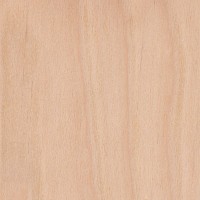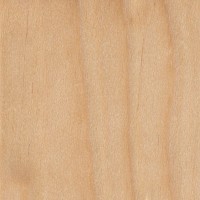 |
Common Name(s): Downy Birch, European White Birch Scientific Name: Betula pubescens Distribution: Northern Europe, Asia, Iceland, and Greenland Tree Size: 33-65 ft (10-20 m) tall, 1-2 ft (.3-.6 m) trunk diameter Average Dried Weight: 39 lbs/ft3 (625 kg/m3) Specific Gravity (Basic, 12% MC): .48, .62 Janka Hardness: 930 lbf (4,140 N)* *Estimated hardness based on specific gravity Modulus of Rupture: 17,760 lbf/in2 (122.5 MPa) Elastic Modulus: 1,745,000 lbf/in2 (12.03 GPa) Crushing Strength: No data available Shrinkage: Radial: 6.0%, Tangential: 10.0%, Volumetric: 16.0%, T/R Ratio: 1.7 |
Color/Appearance: Heartwood tends to be a light reddish brown, with nearly white sapwood. Occasionally figured pieces are available with a wide, shallow curl similar to the curl found in Cherry. There is virtually no color distinction between annual growth rings, giving Birch a somewhat dull, uniform appearance.
Grain/Texture: Grain is generally straight or slightly wavy, with a fine, even texture. Low natural luster.
Endgrain: Diffuse-porous; primarily radial multiples; medium pores in no specific arrangement, moderately numerous to numerous; parenchyma marginal, and sometimes diffuse-in-aggregates (faintly visible with lens); narrow rays, spacing fairly close to close.
Rot Resistance: Birch is perishable, and will readily rot and decay if exposed to the elements. The wood is also susceptible to insect attack.
Workability: Generally easy to work with hand and machine tools, though boards with wild grain can cause grain tearout during machining operations. Turns, glues, and finishes well.
Odor: No characteristic odor.
Allergies/Toxicity: Birch in the Betula genus has been reported as a sensitizer. Usually most common reactions simply include skin and respiratory irritation. See the articles Wood Allergies and Toxicity and Wood Dust Safety for more information.
Pricing/Availability: Likely to be rather economical in most instances. Figured boards can be more expensive, but normally plain birch lumber is in the same price range as maple or oak.
Sustainability: This wood species is not listed in the CITES Appendices or on the IUCN Red List of Threatened Species.
Common Uses: Plywood, boxes, crates, turned objects, interior trim, and other small specialty wood items.
Comments: Birch is one of the most widely used woods for veneer and plywood worldwide. Besides regular sheets of plywood, Birch veneer is also used for doors, furniture, and paneling.
Scans/Pictures: There are currently no pictures of this exact wood species, but a similar species within the Betula genus is being substituted (B. alleghaniensis). If you’d like to contribute a wood sample of this specific species to be scanned, (even small pieces of veneer can be sent), please use the contact form.






Betula pubescens ssp. czerepanovii, earlier counted as its own species (Betula tortuosa) is now categorised as a genetic variant or subspecies of Betula pubescens. It is the love of my life when it comes to the material I choose to carve in from those growing on the farm or in the area.It varies in colour depending on the time of year it is cut, taken in full spring it can have a golden shine that is beautiful, cut after new years in the coldest period it has the least colour and differences. Elevation from sea level affects the density and… Read more »